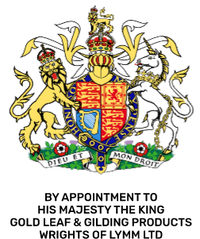Edible Gold Leaf Across the World - New Zealand
- by sam@wrightsoflymm.co.uk User
Introduction
Goldleaf has long been a symbol of luxury and sophistication in food and drink presentation. Across New Zealand, edible gold leaf has become increasingly popular in fine dining, artisan baking, mixology, and cultural celebrations. Whether in the form of 24 carat or 23 carat edible sheets, gold flakes, or even gold dust, this precious ingredient continues to capture the imagination of chefs and consumers alike. Alongside it, silver leaf, silver flakes, and silver dust are also gaining recognition for their shimmering elegance.
In this post, we’ll explore the history of edible gold leaf, its introduction and use in New Zealand, and how it enhances modern cuisine and celebrations.
A Brief History of Edible Gold Leaf
Edible gold leaf has roots stretching back thousands of years. In ancient Egypt, pharaohs consumed gold for its association with eternal life and divine power. In medieval Europe, 23 carat and 24 carat gold leaf were added to dishes at royal feasts to display wealth and extravagance.
24ct gold’s incorruptible nature—it doesn’t tarnish or react with food—made it both safe and symbolic. Across Asia, edible gold became a staple in traditional medicines and cultural rituals, while in India, gold leaf (known as “varak”) has been used to decorate sweets for centuries.
This history of gold in cuisine set the stage for its global spread, eventually reaching the modern kitchens and cocktail bars of New Zealand.
The Arrival of Edible Gold Leaf in New Zealand
New Zealand’s food culture is a vibrant mix of Māori traditions, European influences, and Pacific flavours. As the fine dining scene expanded in the late 20th and early 21st centuries, chefs began experimenting with goldleaf as a garnish to elevate dishes.
With New Zealand’s reputation for fresh, high-quality produce and world-class wine, edible gold flakes and gold dust became a natural addition to premium experiences. Luxury restaurants in Auckland, Wellington, and Queenstown have been known to use 23 carat and 24 carat gold leaf in desserts, cocktails, and even on wagyu beef or seafood platters.
Today, gold and silver leaf products are readily available from specialty suppliers, making them accessible not just to chefs but also to home bakers and event planners.
Culinary Uses of Edible Gold and Silver in New Zealand
Fine Dining & Gourmet Cuisine
Edible gold leaf is often placed delicately on chocolate truffles, macarons, or cakes to give them a striking finish. Silver leaf is sometimes used as a cooler-toned alternative, especially in fusion desserts. Both gold flakes and silver flakes are sprinkled over mains or garnishes for a subtle shimmer.
Mixology & Cocktails
Premium bars in New Zealand increasingly use gold dust and gold flakes to elevate cocktails. A champagne flute with floating 23 carat gold flakes is a common sight at luxury weddings and events. Silver dust is also popular for creating a metallic sheen in craft cocktails.
Weddings & Celebrations
For weddings, anniversaries, and milestone birthdays, edible goldleaf and silver leaf add glamour to tiered cakes, petit fours, and even cultural sweets. Māori and Pasifika-inspired feasts have also embraced gold accents for modern fusion celebrations.
Artisan Baking & Chocolates
New Zealand’s artisan chocolatiers and boutique bakeries frequently decorate pralines, bonbons, and celebration cakes with 23 carat gold leaf or silver flakes. These luxury touches appeal to customers seeking memorable gifts or indulgent experiences.
The Difference Between 23 Carat and 24 Carat Gold Leaf
When purchasing edible gold in New Zealand, you’ll often see 23 carat or 24 carat labels. Both are safe to consume, but the slight difference lies in purity:
-
24 carat gold leaf is pure gold, offering the richest colour and a guaranteed hypoallergenic quality.
-
23 carat gold leaf contains a tiny percentage of another metal, making it slightly more durable but equally stunning.
Both types are approved for culinary use and commonly used across New Zealand’s restaurants and bakeries.
Health and Safety Considerations
Edible goldleaf and silver leaf are classified as biologically inert, meaning they pass through the body without being absorbed. This makes them safe to consume in small decorative quantities. New Zealand food safety standards ensure that edible gold and silver products are of high quality and free from impurities.
Conclusion
From ancient rituals to modern fine dining, edible gold leaf continues to enchant food lovers worldwide—and New Zealand is no exception. Whether in the form of 24 carat gold leaf, 23 carat gold leaf, gold flakes, gold dust, silver leaf, silver flakes, or silver dust, these precious metals add beauty and elegance to every occasion.
In New Zealand, the use of edible gold and silver reflects both a respect for global culinary traditions and a passion for innovation. As food artistry evolves, it’s likely we’ll see even more creative uses of this timeless luxury ingredient.






